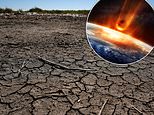Microplastics are discovered in every sample of seafood purchased at a food market – with the equivalent of a grain of rice found in sardine flesh
- Scientists from universities of Queensland and Exeter bought seafood at market
- They dissolved microplastics in the edible tissue of each sample and studied it
- Discovered the microplastic polyvinyl chloride in every single specimen
- Most abundant was polyethylene which is the world's most popular plastic
- Sardines were the worst affected delicacy, with up to 30mg of plastic per serving, approximately the same weight as a grain of rice
Microplastics have been discovered inside every single sample of seafood bought at a market as part of a scientific study.
Researchers cut open oysters, prawns, crabs, squids and sardines and studied them for any sign of microplastics.
Sardines were found to be the worst affected and had ingested the largest amount of plastic, up to 30mg per serving - the same weight as a grain of rice.
Microplastics are tiny particles which are less than five millimetres (0.2 inches) in length.
The health impact of humans ingesting these particles remains a concerning mystery.
Scroll down for video

Researchers from the universities of Queensland and Exeter cut open oysters, prawns, crabs, squids and sardines purchased at an Australian market and studied them for any sign of microplastics
The study was led by the University of Exeter and the University of Queensland and has been published in the journal Environmental Science & Technology.
Academics report plastic levels of 0.04 milligrams (mg) per gram of tissue in squid, 0.07mg in prawns, 0.1mg in oysters, 0.3mg in crabs and 2.9mg in sardines.
'Considering an average serving, a seafood eater could be exposed to approximately 0.7mg of plastic when ingesting an average serving of oysters or squid, and up to 30mg of plastic when eating sardines, respectively,' said lead author Francisca Ribeiro, a PhD student who led the research.
'For comparison, 30mg is the average weight of a grain of rice. Our findings show that the amount of plastics present varies greatly among species, and differs between individuals of the same species.
'From the seafood species tested, sardines had the highest plastic content, which was a surprising result.'

Academics found plastic levels of 0.04 milligrams (mg) per gram of tissue in squid, 0.07mg in prawns, 0.1mg in oysters, 0.3mg in crabs and 2.9mg in sardines

Sardines were found to be the worst affected of the animals tested and ingested the largest amount of plastic, up to 30mg per serving - the same weight as a grain of rice. Microplastics are tiny particles which are less than five millimetres (0.2 inches) long
The researchers wanted to see if and how plastic was affecting a wide range of ocean-dwelling creatures so bought five wild blue crabs, ten oysters, ten farmed tiger prawns, ten wild squid and ten wild sardines.
While they were still raw and fresh, the animals were analysed for five different types of known plastic pollution,: polystyrene, polyethylene, polyvinyl chloride, polypropylene and poly(methyl methacrylate).
All of these polymers are commonly used in plastic packaging and textiles and previous studies have found they make up a lot of marine litter.
Researchers used chemicals to dissolve any plastics in the tissues of the samples and the liquid produced was then put into a machine to determine what type of plastic it was.
'We found polyvinyl chloride – a widely used synthetic plastic polymer – in all samples we tested, but the most common plastic in use today – polyethylene – was the highest concentrate we found,' Ms Ribeiro said.
'Another interesting aspect was the diversity of microplastic types found among species, with polyethylene predominant in fish and polyvinyl chloride, the only plastic detected in oysters.'
Microplastics are being increasingly found around the world, with evidence of them now seen at the bottom of the deepest ocean as well as in the Alps and Antarctica.

Researchers found the microplastic polyvinyl chloride in every single specimen, and this was the only microplastic spotted in oysters (pictured). However, overall, the most abundant microplastic was polyethylene which is the world's most popular plastic

Microplastics enter the waterways through a variety of means and finish suspended in the liquid. They can be transported long distances both in water and via the air, taking them to the furthest corners of the world
They are created when plastics degrade, are washed or broken up, and are hard to catch and destroy.
Due to their prevalence, researchers are desperately trying to understand how harmful they are to human and animal health.
A report commissioned by the United Nations last year found microplastics in drinking water.
This was the first attempt by the WHO to examine the potential human health impacts of exposure to microplastics.
Some of the key findings include the revelation that larger microplastic particles, bigger than 150 micrometres, are likely to be passed out of our bodies without harm.
Smaller particles could potentially be absorbed into our organs, however.
It also suggests microplastics have the potential to both carry disease-causing bacteria and help bacteria become resistant to antibiotics.
Most watched News videos
- Scottish woman has temper tantrum at Nashville airport
- Tesla Cybertruck explodes in front of Trump hotel in Las Vegas
- Mass panic as New Orleans attacker flies down Bourbon street
- Shocking moment zookeeper is fatally mauled by lions in private zoo
- Horrific video shows aftermath of New Orleans truck 'attack'
- Meghan Markle celebrates new year in first Instagram video
- Tesla Cybertruck burns outside Trump hotel in Las Vegas
- See how truck that drove into crowd made it through police barrier
- Cheerful Melania Trump bops to YMCA at Mar-a-Lago NYE bash
- New Orleans terror attack suspect reveals background in video
- Plane passenger throws drink at flight attendant in boozy fight
- Horrifying moment yacht crashes into rocks and sinks off Mexico coast

































































































































































































































































